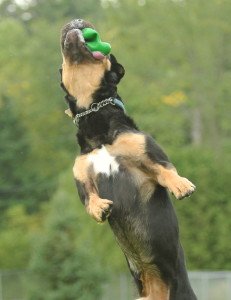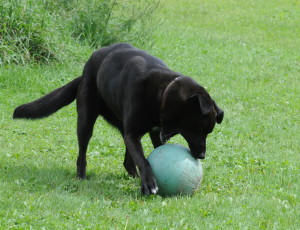Toy Story
 Finding the right toy for your dog can be a bit of a challenge. With so many retailers and products out there, it can be tough to know what toy is appropriate for certain sizes, breeds or types of play. Important information regarding regulations and safety testing may not be available on many products which means it can be tough to make an informed decision.
Finding the right toy for your dog can be a bit of a challenge. With so many retailers and products out there, it can be tough to know what toy is appropriate for certain sizes, breeds or types of play. Important information regarding regulations and safety testing may not be available on many products which means it can be tough to make an informed decision.
At Keshet, we go with the tried, tested and true method. There are certain toys that just don’t measure up to our furry friend’s demands. Then again, there are toys that we turn to time after time and never leave us disappointed. We have one rescue, a Lab/Bernese mix, which takes his job as quality control very seriously and seizes any opportunity to test a toy’s integrity. We have learned that no toy is 100% safe. Swallowing toys, or pieces of them, can cause serious health issues and can become lodged in the gastro-intestinal tract, often requiring surgical removal. They can also cause choking and even poisoning, especially if the toys have batteries or chemical softeners like Bisphenol A (BPA) which are toxic if ingested.
Here are a few things to consider before purchasing toys to ensure your dogs are safe while getting the most out of their toys.
Consider the dog’s size and behavioural tendencies.
If your dog is an aggressive chewer, toys made of plush material or soft rubber are more likely to get destroyed quickly. Toys made of hard rubber or nylon are less likely to tear into smaller pieces.
Choose a toy that is sized appropriately for your dog.
This mostly applies to larger dogs as they can easily chew apart or swallow smaller toys.
Switch out and inspect toys regularly.
Have a set of toys aside and switch them out for the ones currently in use about every month or so. This will help to keep the dog interested in the toys and will provide opportunities to inspect the toys and dispose of any that look iffy.
Remove toys that appear broken or well worn.
If it looks like the integrity of the toy might be questionable, it’s better to remove the toy from play then to risk potential harm.
Buy toys from a reputable and knowledgeable source.
These toys are far more likely to be rigorously tested and specifically regulated for certain use. Information about what the toy is made out of and what degree of chewing/play it can handle is usually on the label.
Research the product.
Ask other dog owners, canine professionals or search online forums to see if a specific toy is appropriate, especially if you have an intense chewer. Often times you can find information about recalls or other problems with the toy from people that have bought the same toys in the past.
 Each dog is different and, much like people, they have preferences and dislikes. For what it’s worth, our best advice is to make the investment of time and money necessary to ensure the toys your dog plays with are safe. Using common sense when selecting an appropriate toy and supervising play time will go a long way to ensuring your dog does not get harmed.
Each dog is different and, much like people, they have preferences and dislikes. For what it’s worth, our best advice is to make the investment of time and money necessary to ensure the toys your dog plays with are safe. Using common sense when selecting an appropriate toy and supervising play time will go a long way to ensuring your dog does not get harmed.

